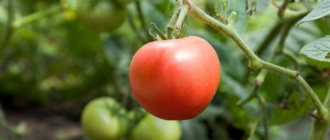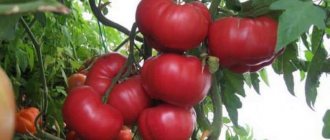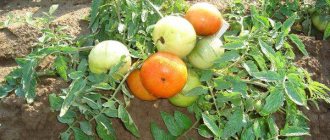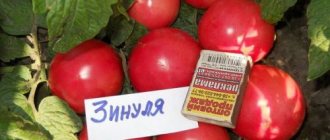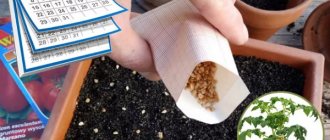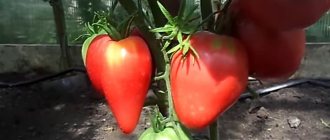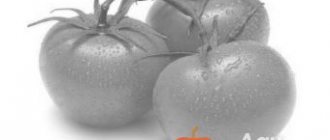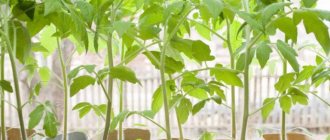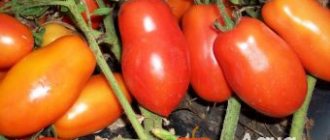The red beauty is distinguished by amazing fruits with glossy skin, on which blue shoulders and green stripes shimmer against a scarlet background. The variety is unpretentious and is actively cultivated in various climatic zones.
| Height | Landing location | Ripening time | Fruit color | Fruit size | Origin | Fruit shape |
| Tall | Greenhouse, Open ground | Mid-season | Bicolor | Large | Variety | Flat-round |
Tomato Beauty F1 - description and characteristics of the variety
Tomatoes are used for preparing many dishes and for canning. Without this unique and healthy vegetable, it is impossible to imagine a complete menu for a modern person. Among the many varieties, gardeners distinguish the Krasotka variety. It is distinguished by the presence of fruits of the same size and bright crimson color. The elastic skin is not at all prone to cracking, which makes the variety suitable for transportation over long distances. Tomato bushes are unpretentious to different climatic conditions and care when growing. They feel good both in greenhouses and in garden beds.
Description of the variety
The variety Krasotka belongs to early ripening vegetable crops. The bushes are of medium height, reaching 80 cm as they grow. The first ovary begins to form above the 6th leaf, and is repeated every 2 leaves. The fruits grow in clusters, each of which contains 6-7 fruits of bright crimson color. For such a beautiful and attractive appearance, the variety received its name.
The shape of the tomato is round, sometimes slightly flattened. The stalk has slight ribbing. The pulp is juicy, fleshy, the taste is sweetish. The average weight of one tomato is about 200 grams. Tomatoes are hybrids.
Growing rules
After the seedlings hatch, you need to remove the film cover. At the stage of 2-4 leaves, plants should be picked into separate cups or pots. Before planting in a permanent place, the seedlings should be accustomed to climatic conditions. To do this, the seedlings must be taken out into the fresh air for several days. When planting in a greenhouse or on the ground, you need to add complex fertilizers to the soil. This will help you get larger, healthier fruits. It is recommended to make holes at a distance of 50 cm from each other. As the plant grows, it needs to be pruned.
Basic care rules
In order for tomato bushes to develop properly and not be subject to diseases and pest invasions, several care rules should be followed.
- Apply mineral fertilizers regularly.
- The soil around the bushes must be loosened, only carefully so as not to damage the root system. Weeds should also be removed on time. They can become carriers of diseases.
- Tomatoes do not like the soil to dry out, so watering should be done in a timely manner. Tomatoes should be watered no more than once a week. Too much water content can also harm the bushes and the roots may begin to rot.
- Despite their high resistance to various diseases and pests, tomatoes are sprayed with special agents for prevention.
Gardeners who grow the Krasotka variety have only positive opinions about tomatoes. Many people like the sweet taste of the fruit and the uniform size of the fruit. Experienced summer residents advise focusing their attention on fertilizing the soil, then the harvest will be rich and the fruits will be larger.
Reviews from gardeners
- Ilya Mikhailovich, 63 years old:
I really liked the Krasotka variety. I have been growing tomatoes all my life, and I often like to buy different seeds for sowing. The tomatoes are very bright and juicy. Any ketchup or tomato juice turns out to be a pleasant bright red color. Caring for bushes is almost no different from caring for other varieties. True, I didn’t do much fertilizing the soil this year, so I think the fruits turned out a little small. Next year I will try to correct the situation and see what the result will be. - Maria, 35 years old:
My husband and I bought a dacha not so long ago, and we always dreamed of growing different varieties of tomatoes here. This year we planted the Krasotka variety and were not disappointed. Bright and sweet tomatoes are great for fresh consumption, as well as for processing. All blanks have an attractive and rich color. All care recommendations were followed, so the tomatoes were large.
Video: Krasotka F1 tomatoes
Forum statistics
208686 Messages in 1636 Topics from 5641 Users. Last user: Cerberus Last message: “Rooting wine cuttings...” ( Today at 06:57:45) Latest messages on the forum.
Now on the forum
64 Guests, 9 Users
Users in the last 15 minutes: Evgeniy 50, Zavezen Oleg Ivanovich, 25nata35, ElenkaF, yotmast, Linx, vladimirM, GALINA ANOKHINA, zsb [Blocked] [Section Moderator] [Forum Moderator]
Maximum online today: 112 . All-time maximum online: 2758 (28 July 2021, 17:22:51)
Users who visited the forum in the last 24 hours
Total: 320
(Visible: 319, Hidden: 1) 1963, Delivered Oleg Ivanovich, Evgeniy 50, 25nata35, ElenkaF, yotmast, Linx, vladimirM, GALINA ANOKHINA, G.V, zsb, Alexey V, Casperzrq, Vova Kapran, Elvira2017, Alexander Vl. , Natasha, DIL, Lyubov S., YurSanych, Capricorn, Nikolay Mikhailovich, Alexander K, vlad51, Andrey 31, Evgeniy 163, Evgen_Ev, Tatyana Provorova, Skif, Leonidych, Victor B, Nikolay Lipunov, sergei, Evgeniy52, 77volt, hanter64, Tatyana B, Kosmos, Slavalimon, Mikhail77, Skier, Rivan, Y_FED, KazAK, Igor Sergeevich, Victor55, Andrey15, Olgaos, Ilya 77, DorNTSOVPET, Chapai, Buba, Mikhno Alexander, Draleyxk1, AlexSandr, AMBER7394, Sao H, pioneer, Dimarostov, Dmitry 77, Verona, DED2, MaxL, nicson7, Vasily V., Kenig, Alexander Taganrog, VitalySD, Dmitry-Kozadoev, Realist, Alexey Deminov, Elektronik_t, Galinka, DSW, Alexey Agryzkov, Taker, Kadyrov, bonami, antar, Sergey 1965 , Andrey Gladilin, SvetlanaBondareva, tolya, Nadezhda Grig, Naumov Igor, Igor F., kvg, Pavel 64, Volgar, Roman Fedorovich, igor222, max2008-01, Iv Iv, Vika, Andrey Lis, Evgeniy30, lomakin1969, linalenadavi, gheo55, Sergey Chistokletov, mystic69, Grinya, Cherkessk, Andrey76, Serzh1978, Haus, , Vladimir-kanevskaya, Iglika, Marina Protasova, Mikhail Alekseevich, Morgana, Igor K, Tatyana Rogacheva, Polyanina Ekaterina, Yuri _Saransk, Sergey 61, Armagnac, Alexander48, tsv , Verbitsky E.I., Lyudmila, Victoria Aleksandrovna, Vladimir Berdnikov, and.drew, Maximilian, Denisovich, Yura Soshnin, Tikhii, Elena Z, Sasha57, Natalia Nikolaevna, Yuri Gaivoronsky, Oleg56, weather forecaster, Lydia58, Vyacheslav03, Sa-shura , irahelm, Pitko, Volodya R, Volgogradka, Alexander71, Natalya1968, Valentina Ivanovna, freesia, L.A.P., Lyuda5, dayton, marlin64, Tanyusha, Vasily1111, Yuri 14, Dmitry Nikolaevich, Oleg Filippov, Valery Rastorguev, Kalevanych, AlexsandrP, LeXa_KoT, Sergey Yuriev, Inna161, cfibr, stenlly2010, rambo, maxbul, Nadymchanka, Ivan Levin, Eduard., nik2, Serginio, potap05, nadia, VeraNiK, Sergey Tashchiyan, Amateur Gardener, Alexander-ask-34, Vladimir Kostochkin , Wintel, Vyacheslav Vladimirovich, mers, Izhitsa, Ramiz, Ahmed, gardener, P7N, alexss, Zaur, TITOVA LYUBOV, Sergey Ko, Tatyana Volzh, Grandfather Young, pioneer-2, ketch, Bublichenko Alexander M, Ildar, Sergei Vasilevi4, Helga , Marshal, Vasily 53, Den, Alexander150, Yavgen3678, vikbublik, Valerie, Henry, Alexander_89, nick041, Svetlana Streletskaya, Antrikan, neposny, yak, Vladimir Buturlakin, Yagodka, Aprel, Antonk1983, PS-URA, spotlight, Nikolay S., Andrey68, Alexander565, Gennady163, AndSanych, Alexander Gay, Alex65, kdm57, oleg9f, Svetlana Korotina, Dmitry Badaev, Belgorodets, Yura, formula1, Cerberus, 64nikolay64, Yuri Semyonov, Kryn, N.A. Sokolov, TIS, Guram, sem_en, Alexander Smirnov, AlexanderD, Spikina Galina, Anatoly Sivkov, Snezhinets, Alexey Sh., mira567, Mst, victor_, Vadim, Salex, Yuri P., Bison, thanatos, Alexander Sh, Vardan, cecet71, Coltrane, Alexander 61, Andrey Beribesov, Efimych, boltik, Vladimir-27, Vovka, LOZA, ilja, Unter, Gela, Irinka, NatalyaMed, ichtiandr, Sergey Lomonosov, krasnovlad1, Irene, Pirko Alexander, Khramov, YATATYANA, , Vitaly Kholkin, Mihalych., ni, Vladimir Kovba, Rita, nau_63, Yuri72, Lisav, niy1, Timofey, NelyaS, MikhAf, Alexander Zinoviev, Zayac, SNovichek, Tatyana A., VDV, Dmitry-Ivanovich, Saisan, slaviking, court, Vladimir Shilov, Oleg Swedov, Sergey2017, Masha_sadovod, Burundukx , Lamo, Oleg A., arnyusha, Leonty Yarygin, Vyacheslav-56, lena, Igor 31, Sergey 31, Zhorzhovich, nut lover, Enych, turist, Ewgeniy, Ivan Shmelev, atseton, Liza
Tomato Red Beauty
photo author Natalya Ananyeva
Description and characteristics of the tomato variety Red Beauty
The original name is Red Beauty , a variety from Brad Gates.
Mid-season, productive, tall, with interestingly colored fruits. In the middle zone, we recommend growing it in a greenhouse.
The plant is of an indeterminate type, strong, up to 2 meters high. Can be formed into 1-3 stems. Regular type sheet. There are up to 8 ovaries in the brush.
Basic qualities of fruits
The fruits are flat-rounded and round, of medium density, red at maturity with anthocyanin streaks on the shoulders and yellow specks towards the bottom. Average weight 100-150 grams. The flesh is red when cut. The taste is pleasant, tomato with sweetness. These tomatoes are suitable for fresh consumption, juices, sauces.
Advantages : long fruiting, resistance to major diseases, high yield.
In some catalogs this variety is called Red Beauty.
Features of cultivation
We recommend sowing the seeds of this tomato variety for seedlings 60-65 days before the intended planting in the ground. Seedlings dive at the stage of two true leaves. When planting seedlings in a permanent place per 1 sq. It is recommended to place up to 3 plants per meter of land.
To obtain tasty and aromatic fruits, tomatoes need loose, humus-rich soil, moderate watering, maximum sun and an optimal number of healthy leaves.
If you grew Red Beauty tomatoes, please write whether you liked them or not. What was the yield and taste of the fruits like under your climatic conditions? How do you rate the disease resistance of this variety? Briefly describe the advantages and disadvantages of this tomato in your opinion. If possible, attach a photo of your tomatoes to your comment. Thank you!
Views of cultivation
The fruit ripening period begins 100-110 days a little after the emergence of seedlings. Seeds need to be sown at the end of March. They are purchased in the store, due to which the hybrids do not retain their characteristics for re-cultivation. Superelite should be kept in a weak manganese solution to disinfect them. The soil should also be treated by pouring boiling water or heating it in the oven at high temperature. You also need to add organic potion to the soil. When sowing, you should not water the soil; you can moisten the soil a little. Seeds are planted in rows to a depth of 1 cm. To speed up the appearance of sprouts, the container is covered with film and put away in a warm place.
After the seedlings hatch, you need to remove the film cover. At the stage of 2-4 leaves, plants should be planted in separate cups or pots. Before planting in a permanent place, the seedlings should be accustomed to climatic conditions. To do this, the seedlings must be taken out in fresh air for several days. When planting in a greenhouse or on alluvium, you need to add complex fertilizers to the soil. This will help produce larger, healthier fruits. It is recommended to make holes from above at a distance of 50 cm from each other. As the plants grow, they need to be pinched.
The best varieties of tomatoes for 2021: photos and descriptions
When choosing tomatoes for their plot, gardeners, first of all, rely on varietal or hybrid characteristics. Productivity is the most important criterion on which the quantity and quality of the harvest depends. Sometimes it can be difficult to choose the right option from the rich variety of tomatoes for open ground and greenhouses. Then varieties are selected depending on the growing region, ripening period, degree of disease resistance and other factors.
Varieties for open ground
A huge number of species with excellent yields are intended for growing vegetables in the open air. Low-growing bushes with large fruits are one of the advantages of tomatoes for the soil. Such heat-loving plants are easier to care for and do not require complex agricultural practices.
According to ripening period
Tomatoes, like other vegetable crops, are characterized by different ripening periods, from early to late.
| Ripening period | Ripening of fruits after the appearance of the first shoots | general characteristics | The most productive tomatoes (2020) |
| Ultra-early ripening | On day 80-85 | The fruits are small, juicy, and low in sugar. The height of the bush is no more than 50 cm. Not suitable for preservation. | Little Red Riding Hood, Pride of Russia, Benito, Superstar, Valentina, Marisha, Maksimka |
| Early ripening | For 90-95 days | Small, delicate fruits, average yield. Suitable for canning and salads. Bushes grow up to 70 cm | Agatha, Riddle, Augustine, Lyana, Sanka, Buyan, Lakomka, Amur standard, Grandmother's kiss |
| Mid-early | On days 100-103 | The fruits are juicy, small, aromatic. The purpose is universal. Bush shape - compact | Openwork, Babushkino, Pulka, Red Giant, Russian Soul, Cardinal, Flamingo |
| Mid-season | On day 100-115 | High taste, excellent yield. There are both low-growing and tall varieties | Scarlet Candles, Hybrid Basket, Stresa, Intuition, Black Baron, Pudovik, Pink Honey |
| Late ripening | On day 120-130 | Excellent fruit taste, high yield, universal purpose. Good keeping quality and transportability of fruits | Giraffe, Cosmonaut Volkov, Titan, Rio Grande, Russian size, King of Kings, Rocket, Premier |
The ripening time, color and shape of tomatoes depends on the variety.
Usually early-ripening vegetables with not large fruits and not a large harvest, but with a quick, friendly yield of ripe tomatoes. Mid-season ones also have medium sizes. Late ones are usually difficult to care for, but it is among them that you can find champions in weight, but there are not many such beauties on the bush.
By growing region
Every year, breeders create new species with high quality indicators. In stores you can buy specialized varieties of tomatoes designed for growing in certain climatic conditions. Classification by regions of Russia:
An unpredictable, cold or, conversely, excessively warm climate is not a reason to refuse to grow tomatoes in open ground. Thanks to selection, varieties have been developed that grow and develop well in any terrain.
According to disease resistance
To obtain a rich harvest, you need to choose tomato varieties not only with the appropriate characteristics. It is necessary that this criterion be supplemented by such an indicator as disease resistance.
Late blight, root rot, tobacco mosaic, cladosporiosis are diseases that most often affect plantings of heat-loving crops.
A catalog of tomatoes that can withstand the onslaught of various diseases:
- Blitz;
- Koenigsberg;
- Geisha;
- Betta,
- Anyuta;
- Bohemia;
- Chio-chio-san;
- Tatiana;
- Puzata hut;
- Lights of Moscow;
- Yablonka Russia;
- Crimson giant.
Unfortunately, there are no varieties that are 100% resistant to infections. But there are hybrids that produce a harvest until the active phase of many fungal diseases and infections begins.
Varieties for greenhouse cultivation
Having a good greenhouse at your disposal, you can get fresh tomatoes to your table all year round. Greenhouse varieties are suitable for preparing salads or canning. Excellent salad tomatoes can be obtained from the following varieties:
- Geisha;
- Fairy gift;
- Andromeda;
- Eagle beak;
- Pink Angel;
- Pink Pearl;
- Fatalist;
- Scarlet caravel;
- Amana orange
The best varieties for preservation:
- Auria;
- Banana legs;
- Pink raisins;
- Rajah;
- Baba;
- Alexander the Great.
Cherries are sweet, small tomatoes that grow well both outdoors and in a greenhouse, but small-fruited vegetables tend to be more productive in protected beds. Magic Harp F1 and Yellow Caramel F1 are hybrids whose fruit weight does not exceed 25 g.
When choosing a vegetable for a greenhouse, many rightly give preference to tall and high-yielding varieties. But low-growing plants, which usually have an early ripening period, as well as mid-ripening tomatoes, are also excellent for polycarbonate shelters in all regions of Russia.
Description and photos of the best hybrids
For open ground, breeders also offer species with high yields of hybrid origin; they are resistant to diseases and temperature changes. The best tomato varieties of 2020:
- Intuition F1 is one of the best tomato hybrids for picking with trusses, mid-season, from germination to harvesting the first vegetables - 110 days.
- Katya F1 is an early ripening hybrid. The fruits weigh 90-130 g and ripen simultaneously. From 1 m² you can harvest more than 10 kg of fruit per season.
- Search F1 – unpretentious and at the same time tasty tomatoes. The hybrid withstands cold weather and is immune to most diseases. The bushes are strewn with small red fruits, which are excellent for pickling and canning.
- Blagovest F1 is an early-ripening hybrid. The fruits are round, glossy, with slightly pronounced ribbing. From one bush you can collect up to 5 kg of fruit.
- La la fa F1 - has excellent consumer qualities, high yield and unpretentiousness. The average weight of the fruit is 140-170 g. From 1 m² you can harvest up to 20 kg.
- Vladimir F1 - has a high yield and is suitable for cultivation in any type of soil. High productivity throughout the entire fruiting period.
- Beef King F1 is an early maturing Dutch hybrid. The tomatoes are round, dense, smooth. From one bush you can collect up to 4-5 kg. Resistant to low temperatures and diseases.
- Ashdod F1 – tomatoes with smooth, dense skin. Fruit weight is from 110 to 140 g. The pulp has a bright burgundy color.
- Tanya F1 is a hybrid from the Netherlands with excellent immunity, dense structure, and good yield. The fruits have a regular round shape, weighing 150-200 g. They tolerate transportation well.
Tomato Beauty f1 characteristics and description of the variety, its yield with photos
Description of the tomato variety Novichok
Initially, the Novichok tomato variety, a photo and description of which is given in the article, was intended for commercial production in agricultural enterprises in the southern regions. It was supposed to be grown in open ground. However, it quickly spread throughout the European part of Russia. They know about the variety in the Urals, Siberia and the Far East. The variety bears fruit well both in open ground and in greenhouses and greenhouses.
The agricultural technology of the Novichok tomato is one of the simplest. This is due to the unpretentiousness of the variety, the short stature of the plants, and the formation of a small number of stepsons. Characteristics and reviews of the Novichok tomato say that it is highly resistant to late blight and other fungal diseases. This reduces the number of treatments and makes maintenance easier. However, the variety is heat-loving and prefers well-fertilized soils.
The variety is determinate and is distinguished by small, compact bushes. The height of the Novichok tomato is 60-85 cm. The plant is not a standard species and produces an average number of shoots. They are powerful, gray-green in color. However, during fruiting they need support. The reason for this is the large number of fruits.
The leaves are medium sized, the usual shape for a tomato. Slightly wrinkled, with pronounced veins. The leaf blades of a healthy plant are dark green in color and have a barely noticeable edge on the back side.
The newbie blooms with medium-sized yellow funnel-shaped flowers. Inflorescences are collected in brushes of 4-6 pieces in one brush. The first brush is usually formed above the 6th leaf. Next, the tomato lays the brushes through 1-2 leaves. By the time of fruiting, the entire tomato bush is covered with fruits.
It is generally accepted that the shape of the fruit of the Novichok tomato resembles “cream”. However, they are more likely to have a spindle-shaped or cone-shaped shape, tapering towards the nose. The stalk exhibits slight ribbing.
The tomatoes are small, with an average weight of 75-100 grams. Housewives like to use these tomatoes for canning. They fit easily into a jar. The color of ripe fruits is bright, red, without a greenish spot at the stalk.
Currently, it is possible to grow only the Novichok variety of red tomatoes, but also pink ones. They were released in 2006.
The variety has good taste. Their tasting score is 4.6 out of 5. It could be higher, but many people don’t like the thick skin. Novichok tomatoes are fleshy, the number of seeds inside the fruit is small. The fruits are sweet, with slight sourness and a bright aroma.
Advantages and disadvantages
Planting and care
In the southern regions, Novichok is planted with seeds in the ground. Thanks to the relatively early ripening period, it has time to ripen. In the middle zone, preference is given to growing by seedlings.
Novichok tomato seeds are sown for seedlings in mid-March if you plan to grow tomatoes in a greenhouse, and at the end of the first spring month if planting in open ground is planned.
The seeds have good germination and are not particularly demanding on the composition of the soil. Most vegetable growers prefer to use commercial soil mixture. Those who prefer to prepare it themselves will have to mix garden soil, soil from the area where they plan to plant tomatoes, compost or humus in equal parts.
Tomato Novichok is a variety. If the seeds were collected independently last season, then it is worth checking their quality and treating them against fungal infections.
Seeds are planted in containers on compacted and well-moistened soil. Scheme for planting tomatoes Novichok 1*3 cm. The crops are mulched with a mixture of peat and soil, moistened abundantly and covered with glass or covered with film. The first shoots should appear in 4-7 days.
Characteristics of the Lorraine beauty tomato
Tomatoes Lorraine beauty are an indeterminate variety, not standard, tall. The bush reaches 1.5 m in height. The shoots are straight, thin, green without pubescence. The foliage is weak. The leaf blade is green or light green, elongated, with cut edges, pointed at the tip.
The plant has a medium-late ripening period: the fruits are harvested 110-120 days after the appearance of the first shoots.
The tomato is large, the average weight is 450-500 g. The shape is ribbed, corrugated, and in cross section resembles a flower. The surface is bright red, dense. Inside contains dryish pulp with a pleasant sweet taste. The internal chambers have voids, so the juiciness of the fruit is average.
Fruit characteristics
The Lorraine beauty tomato is an elegant large, ribbed, rounded fruit, flattened at the top. Outwardly they look like a closed flower with wide petals. The color of ripe tomatoes is bright scarlet. Weight is 200-350 grams, with proper agricultural technology it can reach half a kilogram.
The inside is multi-chambered, hollow, almost without seeds. The taste is sweetish with sourness. Suitable only for fresh consumption - slicing or stuffing looks impressive on the table. Dense, resistant to cracking. They are stored for a long time. They ripen well when picked brown.
Properties of the variety
The tomato is of American origin, more precisely of US selection. Tomatoes are of indeterminate type, with a height of 1.5 to 2 meters. The average late ripening period is 110-120 days. It is grown both in greenhouses and open ground. Self-pollinating. Productivity is low - no more than 3-4 kg per bush. Under unfavorable weather conditions, you can generally get 2-3 tomatoes.
The characteristics of resistance to viral and fungal diseases are as follows: resistant to Fusarium wilt, gray leaf spot, tobacco mosaic, Alternaria stem cancer, verticillium, cladosporiosis, nematode. Not resistant to root and white rot.
The bush is not standard - the stems are thin in constitution, large, slightly corrugated leaves. You can also add to the description of the variety that due to its specificity, it is not grown in agriculture on an industrial scale. This is a tomato for amateur gardeners and collectors of unusual plants.
Productivity
From 1 m2 they collect 6-9 kg. Hence the conclusion is that the yield is high.
Features of cultivation
Tomatoes of the Lorraine Beauty variety are no different in cultivation technology from most classic varieties:
- sowing seeds - obtaining seedlings.
- picking.
- transplanting.
- cultivation - watering, fertilizing, garter formation.
- harvesting.
Sowing seeds for seedlings for open ground, taking into account the climate zone, is carried out no earlier than two months before the onset of stable warm weather. After 3-4 weeks, in the phase of 2-3 true leaves, they peak. They are planted approximately 30 days after picking. If warm weather has not yet established itself, the seedlings should be “tempered” - treated with the drug “Tur” or another growth regulator to avoid overgrowth.
The planting pattern is 60 x 50. The interval along the rows is 60 cm, between plants 45-50. Due to its resistance to cracking, the beauty does not require strict adherence to the watering regime, but the soil should not be allowed to dry out too much.
The formation of the bush is carried out by removing the stepsons and gartering. It is produced in one trunk, however, according to reviews from gardeners, there is successful experience in growing tomatoes in two trunks.
Selection of fertilizers according to the classic P-NK scheme. During the development period, the complex contains a large percentage of nitrogen, during flowering and ovary - phosphorus, and when fruits ripen, potassium is needed. To prevent blossom end rot, periodically give Ca, that is, calcium nitrate. Fruiting continues as long as weather conditions permit. With the onset of cold weather, the still green fruits will grow well at room temperature.
Advantages and disadvantages
The main advantages of the Lorraine Beauty variety:
- very impressive appearance of the fruit;
- pleasant sweetish taste;
- It is convenient to tie up bushes that are not too tall;
- good yield;
- resistance to viral diseases.
The yield indicators of different varieties can be found in the table:
| Variety name | Productivity |
| Lorraine Beauty | 5-7 kg per bush |
| Bobcat | 4-6 kg per bush |
| Apples in the snow | 2.5 kg per bush |
| Russian size | 7-8 kg per square meter |
| Yablonka Russia | 3-5 kg per bush |
| King of Kings | 5 kg per bush |
| Kate | 15 kg per square meter |
| Long Keeper | 4-6 kg per bush |
| Raspberry ringing | 18 kg per square meter |
| Grandma's gift | 6 kg per square meter |
| Crystal | 9.5-12 kg per square meter |
Among the shortcomings are noted:
- insufficient juiciness, “hollowness”;
- in open ground in cool weather the yield is significantly reduced;
- at insufficient temperatures, not all ovaries have time to develop into fruits.
Advantages and disadvantages compared to other similar varieties
The Lorraine beauty tomato is grown infrequently, but is well described in the literature, and there are reviews about it from amateur gardeners. At the same time, both the advantages of the variety and its disadvantages are noted. The advantages include:
- original unusual appearance of tomatoes;
- long-term preservation and transportability of fruits;
- the ability of tomatoes to ripen during storage;
- good, for an ornamental variety, sweetish taste;
- resistance to a number of diseases.
The list of disadvantages includes:
- hollowness of fruits;
- presence of dryness in taste;
- unsuitability of fruits for processing;
- significant dependence of yield on weather.
So, in the central zone of our country, the Lorraine beauty can still be grown in unprotected soil, but a little further north it can bear fruit normally only in greenhouses.
There are very few varieties intended specifically for decoration, but there are tomatoes with a similar, strongly ribbed fruit shape. Thus, the new domestic variety Garmoshka is considered a salad variety and is characterized by excellent taste and high yield. The fruits are pink, pear-shaped, strongly ribbed, very large. The Mushroom Basket tomato has good taste; the yield of strongly ribbed, flat-round pink fruits is at the same level as that of the Lorraine beauty. The very large ribbed fruits of the Cheerful Neighbor tomato, which appeared only a few years ago, have good taste and high yield.
Characteristics of the Beauty tomato and growing a hybrid variety
Tomato Beauty f1 got its name because of its beautiful appearance. During the period of full ripening, Beauty pleases its owners with bright crimson tomatoes. The shape and size of all fruits are almost the same. Tomatoes have elastic skin that is not prone to cracking. This makes them resistant to transportation and long-term storage. Fruit weight – 150-200 g.
What is a Beauty tomato?
The characteristics and description of the variety are as follows:
- The tomato ripens in 100-110 days.
- This is a hybrid variety that is resistant to weather conditions and various diseases.
- High yield and good taste are the main indicators of tomatoes.
- This variety can be grown in any region of our country.
- Tomatoes are planted in open ground in warm areas, and in cold areas - under a film cover. At temperatures below +16…+17ºС the plant dies.
